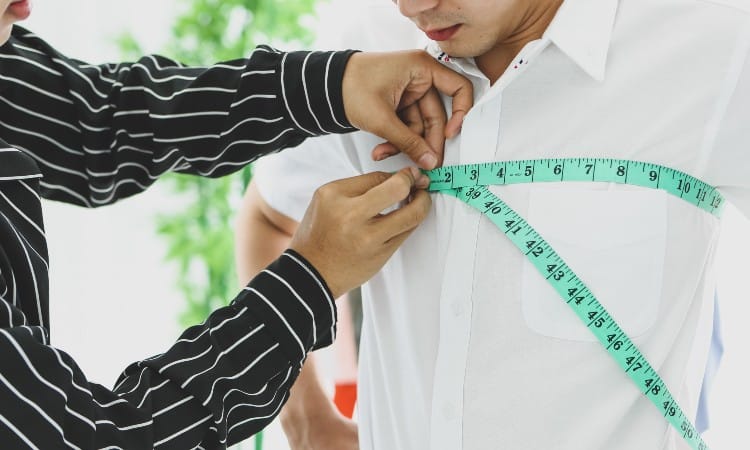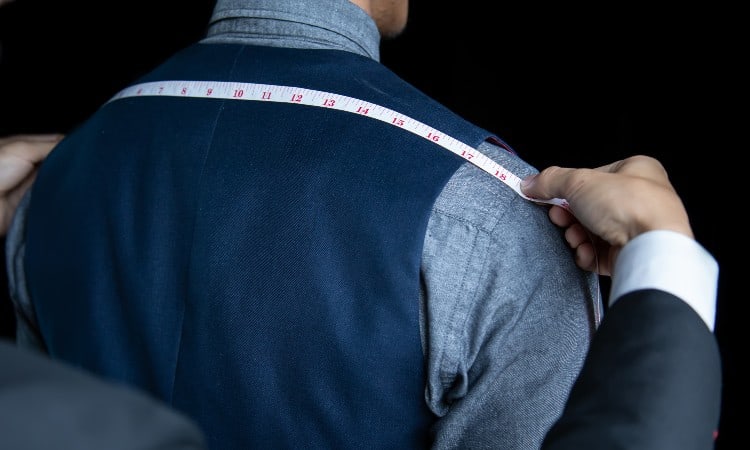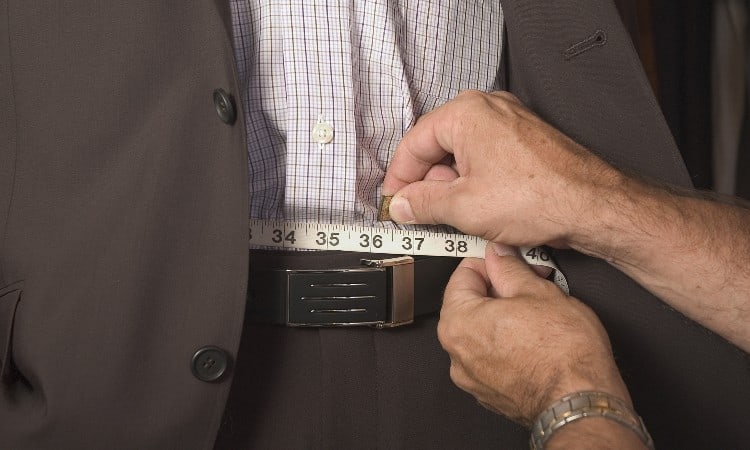Few types of clothing look as professional, formal, or just plain sexy as a well-fitted suit jacket. The key to pulling off this classic style for both men and women is to buy the right size of suit jacket. Fortunately, you can check out this handy guide to learn how to measure suit jacket size for yourself!
Suit jacket sizes consist of two elements: a number describing the chest size and a letter indicating the jacket length. The chest size of the jacket always uses an even number and often falls between 34 and 52. Suit jacket sizes list the length as S for short, R for regular, or L for long.
In this article, you will learn how to measure key areas of your body to get the perfect size of suit jacket for you. You will find tips for understanding suit jacket sizes for both men and women. Finally, you will discover how a suit jacket should fit your body.

How Do You Read Suit Jacket Sizes?
The trick to reading suit jacket sizes for men is to realize that the number indicates the chest measurement of the jacket, and the letter indicates the length of the jacket. For example, a jacket size of 40R means that the jacket has a chest measurement of 40 inches and a “regular” length.
Most brands list jacket lengths as S for short, R for regular, or L for long. What exactly do short, regular, and long mean? Well, that can vary from brand to brand!
You will find tips for how to measure jacket length later in this article.
For women, suit jackets typically use a numeric system of even numbers, starting at 0 and progressing to 16 or 18. Typically, jacket sizes follow the same measuring system used for women’s blouse or shirt sizes in this regard. Bust, shoulder-to-hip, and arm measurements will help you choose the right size women’s jackets from a particular brand.
How to Measure Suit Jacket Size: Key Measurements
The key to finding a jacket that fits you perfectly is to start by knowing your own measurements. For men, this includes the chest, arm length, jacket length, and neck measurements. For women, this includes the bust, arm, and torso length measurements.
Chest/Bust

The most important measurement you need to take before buying a suit jacket is your chest or bust size. If you can, get someone else to help you take this measurement. A second person can keep the tape level as it circles your upper torso much more easily than you can alone.
- Hold your arms slightly out from your sides.
- Wrap the tape around the widest portion of your chest, just below your armpits.
- For women, choose the fullest portion of the bust for this starting point.
- Circle the tape completely around your torso at this point, making sure it remains level. If you don’t have someone else to help you, position yourself with your back to a mirror so that you can check on the levelness of the tape.
- Pinch the tape together where it meets up at your starting point. Write down this measurement in inches.
Now that you have the physical measurement of your chest, you can use that number as a starting point to pinpoint the chest measurement of the jacket you want.
- For a casual suit jacket or a blazer, add an inch to your measurement. This means that the chest circumference of the jacket will not cling to your body and will give you a looser fit.
- For a more fitted jacket, use your actual chest measurement rounded up to the nearest full number.
- Many jacket brands add three to four inches in the chest, so don’t worry if the jacket you buy does not have the same measurement as your chest!
Shoulders

Measuring the width of your shoulders helps you pick out a jacket that looks as if you had it tailored to fit your body. Nothing looks worse than a baggy suit jacket with shoulders that droop, but nothing looks better than a jacket with shoulder seams that line up precisely with the ends of your shoulders!
- Stand with your feet flat on the floor and your shoulders straight but relaxed.
- Have a friend wrap a tape measure around your shoulders, from the outside edge of one shoulder to the other, and then curve around your back between your shoulder blades.
- Write down this number.
Jacket sizes do not directly include the shoulder measurement the way they do the chest measurement. However, you can find shoulder width listed in the brand’s sizing chart, which will help you select the size of jacket that fits you most precisely. Both men’s and women’s sizing charts for jackets should include this measurement.
Waist

Measuring your waist is essential if you want a fitted suit jacket that dips in the narrowest portion of your torso. You don’t want to buy a snappy new suit jacket only to realize that you can’t button it because the waist portion of the jacket is an inch too small! This holds true for both men’s and women’s jackets.
- Stand with your feet slightly apart, pointing straight ahead, and flat on the floor.
- Locate your natural waist by finding the most narrow part of your torso. You can also measure two inches down from your navel to find this point.
- Wrap a tape measure around your torso at this point, keeping the tape level as it circles your lower back.
- Write down this measurement.
Length
Besides the chest or bust measurement, the length of a suit jacket is the most important measurement you need to take. It determines where the lowest edge of the jacket will fall on your body.
If at all possible, have someone else take this measurement for you so that you can stand with both hands lose.
- Stand up straight with both arms hanging loose at your sides.
- Have your friend use a ruler to connect a straight line from the lowest knuckle on your thumb to the inside of your thigh. Mark this point with a safety pin or a chalk dot on your pants.
- Now use a tape measure to measure from the base of your neck to that marking. Essentially, you want to measure the length between your neck and your thumb.
- Write down this measurement.
The “correct” length for a suit jacket does change from one fashion era to another, but the current trend is for a pretty long jacket. For men, you typically want the lower hem of the suit jacket to end somewhere between the two knuckles on your thumb when your arms hang loose at your sides. It always looks best to have a jacket that gracefully falls past your waist and covers at least the upper portion of your seat and thighs.
Women’s suit jackets come in a greater range of styles, such as waist-length Chanel-style wool jackets with matching pencil skirts. It is tough to claim any one correct length for women’s suit jackets!
Some brands also provide charts listing your overall height to get the best suit jacket length. This does not work perfectly, as every person has a differently proportioned torso and leg length, but it does work as a starting point!
Sleeve

The key to getting an accurate sleeve length measurement for a suit jacket is to bend your arm slightly before you begin.
- Stand with your feet planted, your shoulders relaxed, and your back straight. Most importantly, hold your arms loose and slightly bent at your side.
- Place the short end of the tape at the tip of your shoulder or where the shoulder seam on a shirt will lie.
- Trace the tape smoothly down the outside of your arm, around your bent elbow, and past your wrist.
- Stop at the base of your thumb.
- Write down this measurement.
For most suit jacket styles, you want the hem of the sleeve to end just a fraction above the end of the sleeve cuff. This allows your crisp shirt cuff to show. You can even flash a fancy cufflink if you want!
Suit Jacket Sizes For Men
Suit jacket sizes for men use a two-part formula that lists a number and then a letter. The number, always double digits, lists the chest measurement of the jacket, such as 44 inches, 52 inches, and so on. The letter describes the length of the jacket.
For jacket length, S means short, R means Regular, and L means long. XS means extra short and XL means (you guessed it) extra long. The tricky thing is that “regular” or “long” can mean different lengths from one brand to another!
That said, knowing that a size 44R suit jacket has a chest measurement of 44 inches and an average length can give you a good starting point as you shop. You will want to compare your actual measurements to the sizing chart offered by the brand before you make a purchase, though.
Suit Jacket Sizes For Women

Suit jackets for women use an even numbering system starting at 0 and going up by twos, such as 2, 4, 6, and so on. This sizing system is the standard method used for most women’s clothing in the United States. The most important measurement for determining your suit jacket size is the bust measurement, which is almost always the widest portion of the torso.
The key thing to know about women’s suit jacket sizes is that no standardized measurement system is used to determine what shape or size of a jacket falls into the size 2, 4, or even 20 categories! Of course, you can find some generalities among popular brands, but the only way to get a jacket that fits you is to take your own measurements and compare them to a sizing chart.
Another challenging factor as you find a women’s suit jacket you like is that women’s suits come in many more different shapes and styles than men’s suits. Men’s suits always feature a jacket and a pair of pants.
Women’s suits may include pants, or they could rock a pencil skirt instead. Women’s suit jackets might have the classic mid-thigh cut or end at the skirt’s waistband.
Why does all this variation matter? Well, for a fitted suit jacket that has a peplum waist, the waist measurement is essential. But for a loose, boxy suit jacket, the bust and shoulder measurements will matter much more.
How to Measure Suit Jacket Size Without Tape
If you do not have a flexible tape measure handy, you can measure for a suit jacket using a piece of string, rope, or even a pair of yoga pants!
- All you have to do is use the string, rope, etc. as if it were a measuring tape. Wrap it around your chest or trace it down your arm. But make sure you mark the start and end points on the string using a piece of chalk.
- Next, take your improvised measuring tool to a flat surface and stretch it out. If you have a ruler or a metal tape measure, use that to trace the distance between your marked start and stop points on the string. If you do not, you can even use a piece of printer paper with a standard distance of 11 inches.
Of course, it is much easier to measure yourself if you have a tape measure! You can buy a small, flexible sewing tape measure in cheap sewing kits at Walmart or most dollar stores.
Suit Measurements Template
If you want to buy a custom-made or bespoke suit, you will discover that many tailors or brands that offers this service require you to fill out a suit measurements template form. This template simply asks you to fill in the blanks by providing your personal measurements so that the suit can fit the shape of your body.
Most suit measurement templates include the chest, waist, sleeve length, and jacket length measurements described earlier in this article. They often come with directions for how to take the measurements.
Men’s Suit Jacket Size Chart
This sample men’s suit jacket size chart shows how suit jacket sizes compare to average measurements. Of course, you do need to remember that actual measurements will vary from one brand to another! This is a sample; you should always check the specific sizing chart for the jacket you like before making a purchase.
| Size | Chest | Waist | Sleeve | Length |
| 34R | 34” | 28” | 31.5” | 30” |
| 34L | 34” | 28” | 31.5” | 31” |
| 38R | 38” | 32” | 32.5” | 31” |
| 38L | 38” | 32” | 32.5” | 32” |
Suit Size Calculator Weight/Height
While not quite as precise as taking your own measurements, you can also estimate your suit jacket size by using a weight and/or height calculator. In fact, some brands use a height metric to determine your suit size anyway!
You can do this in two ways. First, you can use free online calculators like this one to guesstimate your suit jacket size by inputting your weight and/or height.
Second, you can read a height sizing chart provided by some brands and select your size based on your height.
Where to Get Measured for a Suit for Free
Most tuxedo rental locations or department stores that sell suits will take your measurements for free. You should call ahead to find out if a specific store offers this service!
Check out:
- Men’s Wearhouse
- Macy’s department store
- Dillards
- Ingram’s
- Brook’s Brothers
- Tux Shop
The most professional option is to go to a tailor and get yourself measured by a true master. But this may cost something unless you order a bespoke suit from the tailor.
How Should a Suit Jacket Fit Your Body Type?
How a suit jacket fits your body type can highlight key features like broad shoulders or downplay other elements like a rounded stomach. Check out these tips to help you find just the right kind of suit jacket for your body type!
- If you have a somewhat oval body shape, try a tapered single-breasted jacket. This will make it look as if your torso curves at the waist. You should also get a jacket with shoulder pads, as this will make your shoulders seem broader and balance the rounder lines of your body.
- For a triangular body type, leave the shoulder pads and go with a softer shoulder to balance out your broad shoulder line and narrow waist. But make sure you wear tapered jackets that nip in at the waist and highlight your toned physique!
- If you have a somewhat rectangular body with shoulders, hips, and legs that all form a straight line, try drawing the eye to your shoulders by wearing a suit jacket with structured shoulder pads. Avoid double-breasted jackets that have a more rectangular appearance than single-breasted jackets.
- For short men, try wearing single-breasted suit jackets that draw a vertical line with their shape. Narrow lapels and a short jacket length will also make you look taller and skinnier.
- For tall men, make sure you find a suit jacket that fits you pretty closely. Don’t settle for a boxy, off-the-rack jacket! A nice jacket that fits at your shoulders and your waist will make you look balanced and elegant without diminishing your height.
Conclusion
The key to finding a suit jacket that fits you just right is to take your own measurements accurately. The most important measurements for a men’s suit jacket include the chest, waist, sleeve length, and jacket length. For women, the most important measurements include the bust, shoulder width, and waist measurements.
Men’s suit jacket sizes use a double-digit number followed by a letter, such as 34R. The number describes the chest measurement of the jacket in inches, while the letter indicates the short regular or long length of the jacket. Women’s suit jackets typically use an even-numbered sizing system beginning at 0 and working up by twos.